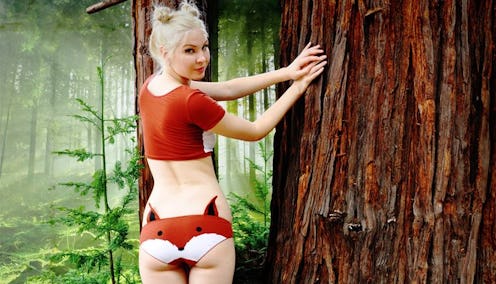Fashion
Why Are Forest Animal Patterns So Popular?

Fawns and foxes and owls, oh my! Why are fairytale animals so popular in fashion? You can't browse ModCloth or Etsy without seeing a pattern that features forest critters, like panties with a fox face. InStyle called the trend "Natural Wonders" and informed us, "Strewn with ethereal flowers, woodland motifs, and a flurry of delicate winged creatures, these fanciful pieces conjure images of a magical realm. Thankfully, they exist to be worn farther than the bottom of the garden."
Apparently this is a trend for the ages, or at least for the past couple of decades: In 1994 The Baltimore Sun advised evoking the forest with home decor, counseling readers, "Centerpieces chosen from nature make dramatic crowning touches." Reaching back 20 more years, Los Angeles Times compiled a timeline to address the question, "Where did the owl craze start, and how did it take flight?" Their answer is 1971, when "Woodsy Owl [became] the U.S. Forest Service's mascot, with the motto, 'Give a hoot! Don't pollute.' The conservation movement just may have triggered the first wave of owl mania." An accompanying photo shows Woodsy posed with Zsa Zsa Gabor.
Current divas take note: Fall 2014 brought a resurgence of woodland imagery, focusing on clothes. Online retailer Garnet Hill posted, "In our neck of the woods, it's all about artsy woodland creatures — think deer and foxes, pheasants and rabbits." Glamour's Nikki Ogunnaike took the same angle that I did, writing, "Swans and puppies and foxes, oh my! This season, designers took a walk on the wild side, incorporating animal motifs into their collections. Wear [a print] frock or a simple bird-embossed piece — it's up to you!" Up to me? Golly!
But wait, the woodland theme started getting re-revved up earlier than 2014. Back in 2012, Tania Braukämper cautioned Fashionising readers to remember "animal faces for fall. You must have seen [the] furry faces, peeping out from shop windows, emblazoned across bags, innocently snuggled into... autumn knits." Editd and The Independent concurred. In February, 2013, The Hindu also noted the trend.
Most of the writers I quoted above emphasize fall, making me think that I might be bucking the trend by wondering about this as spring approaches. Hey, maybe I'm feeling Bambified because the robins have started hopping around on my front lawn, pecking for bugs and fluffing their feathers when they take a break. (It's hard work to be an adorable chubby bird!)
Part of me thinks, "No one needs an excuse to want to wear pictures of super cute animals." Isn't that basically the reason why Hello Kitty is a hit? Hello Kitty is precious. End of story. She doesn't need anything else to be appealing. The other part of me, the annoyingly academic side, wants to know what it means. Sociocultural trends always indicate something about the zeitgeist, illuminating the psyche of the times. Seriously, ModCloth has an entire "Woodland Creatures" section. Based on how immensely popular the retailer has become, I assume they do market research and choose stock in response to desires that customers have expressed.
Here's my theory: We like woodland creatures and other forest imagery because the aesthetic is a throwback to childhood, to the "magical realm" of fairytales and Disney protagonists. Being a grownup entails constant exhausting demands on your time and energy. At least we can comfort ourselves by dressing down, agewise. This is not to say that fawns, foxes, or owls are explicitly childish. After all, "foxy" means "sexy," an adult attribute if there ever was one, and rapper Foxy Brown didn't choose the moniker to appeal to the toddler demographic:
What a babe, right? Anyway, animals have full life cycles, from sweet little baby muffins to crotchety old creatures. Yet the vulpine likenesses printed on shirts and accessories tend toward a younger aspect, like this "Found Your Fox" bag:
Are we sure that this pretty munchkin is old enough to leave its mother?
Leopard print is a whole different ball of wax. Big-cat and safari animal prints — leopard, cheetah, zebra, giraffe, tiger — espouse wildness and ferocity. Woodland motifs are about innocence. At least in my estimation — TrendHunter has a different, but related, suggestion of meaning: "As people move to the city, nature — especially the deep forest — holds more appeal [because it is a] foreign place. Advertisers and fashion designers are capitalizing on this intrigue by using the forest as a backdrop to... campaigns with a woodland theme." I look at the work of a chic illustrator like Clare Dean, who runs Bows & Thickets, a blog billed as a "fashion and style magazine for woodland creatures," and I feel like my theory is supported. Doesn't this illustration, also sold as fabric on Spoonflower, remind you of something from a kids' book?
Someone sew me a sundress dappled with dancing hedgehogs and bunnies. I'll wear it a thousand times this spring! Let me know on Twitter if you have an alternate idea about why woodland motifs are so prominent in modern closets.
Images: Etsy/knickerocker; Giphy; ModCloth; Bows & Thickets